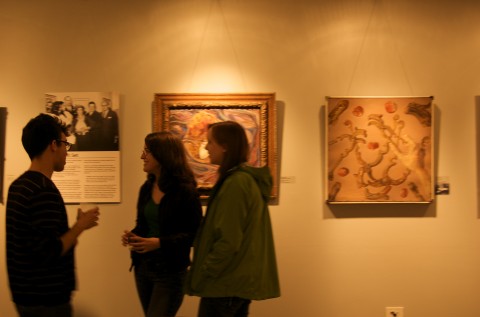
Students admire nutty pieces of artwork.
The walls are lined with paintings of chestnuts. A sculpture at the front of the room displays nuts attached to a metal wire. A photo of the worlds largest nut, a thirty-five pound Coco-de-Mer, is hanging in the corner. This must be squirrel heaven, right? Wrong. This is an exhibit of the work of Elizabeth Tashjian, known as the Nut Lady, that was displayed in a beautiful exhibit in Cummings last Thursday.
Born in New York City in 1912, Tashjian began studying art at the National Academy of Design and eventually owned a studio in Carnegie Hall in the 1940s. The success of her first piece that appeared in a show, a painting of a cluster of chestnuts next to a towering nutcracker, began Tashjian’s fascination with nuts as the subject of her art. “When I discovered nuts — that is artistically, of course, for long were they edible delights — both enchantment and professional obligation possessed me”, said Tashjian in an interview.
Nuts continued to play an important role in Tashjian’s life, and she transformed the first floor of her home in Old Lyme, Connecticut into a Nut Museum including everything from her paintings to masks created to depict characteristics or “whimsical suggestions” of different nuts, which Tashjian would allow guests to try on. One of the most shocking items in the museum was the aforementioned Coco-de-Mer, the shape of which strangely resembles the pelvis and thighs of a woman. This was donated to Tashjian and she brought it to many interviews and television appearances as she became more well-known.
Many of these hilarious but heartwarming T.V. appearances were being looped on a projector on the back wall of the exhibit. Tashjian appeared on The Tonight Show a number of times, showing off her Coco-de-Mer and singing songs she had written about nuts. Tashjian didn’t seem to mind when Johnny Carson poked fun at her on one episode, and she even made some subtle (though possibly unintentional) naughty nut jokes.
Although Nut Lady was often teased for her intense appreciation for nuts, Tashjian did have some very interesting philosophical ideas concerning her beloved nuts. In 1972, she began to create art depicting anthropomorphic nuts — in other words, paintings of nuts that look human and humans that resembled nuts. You might be wondering, as I did, if this woman was just truly nutty, but there was a deeper meaning to these kinds of pieces. “I have set ten million people free who thought they were nuts,” said Tashjian, “you can no longer pinpoint and say so-and-so is a nut, and so-and-so isn’t. We all come from the same shell.”
Professors McCabe and Steiner were both lucky enough to meet the Nut Lady before she passed away. “I probably have more than 25 hours of recordings of interviews with her”, said Steiner. “When she went into a coma in 2001, nobody thought she would make it, so her house was seized by the government.” Once Tashjian miraculously recovered, she had almost run out of money and no longer had a home, so she was moved to a nursing home to live out the last years of her life. The contents of the Nut Museum were going to be given away by the government, and Connecticut College was lucky enough to receive many of the pieces of art because of Tashjian’s connection to McCabe and Steiner. Tashjian was certainly quite a character and it is easy to brush off her work as frivolous, but there is a beauty and a profundity to her art that cannot be denied. Looking around the beautifully procured exhibit, Devon Elovitz ’13 decided, “She would have been happy to see this.” •









oh nice